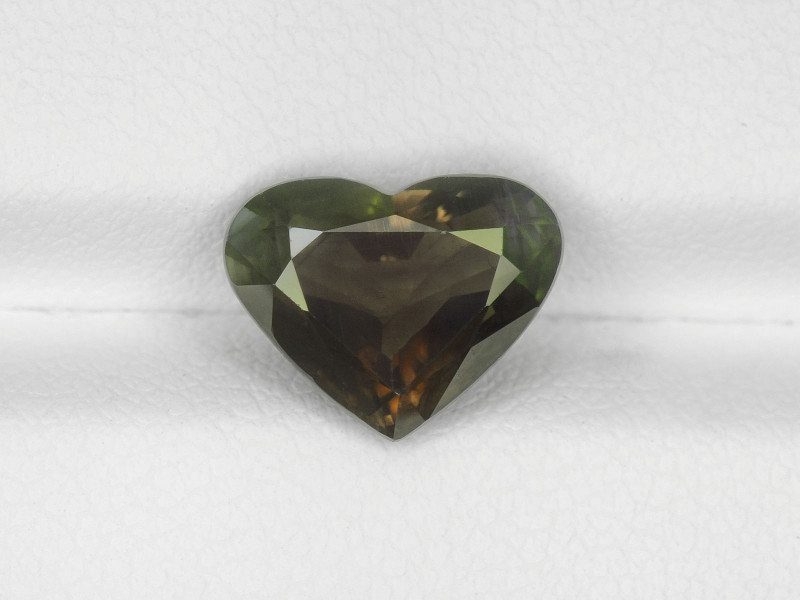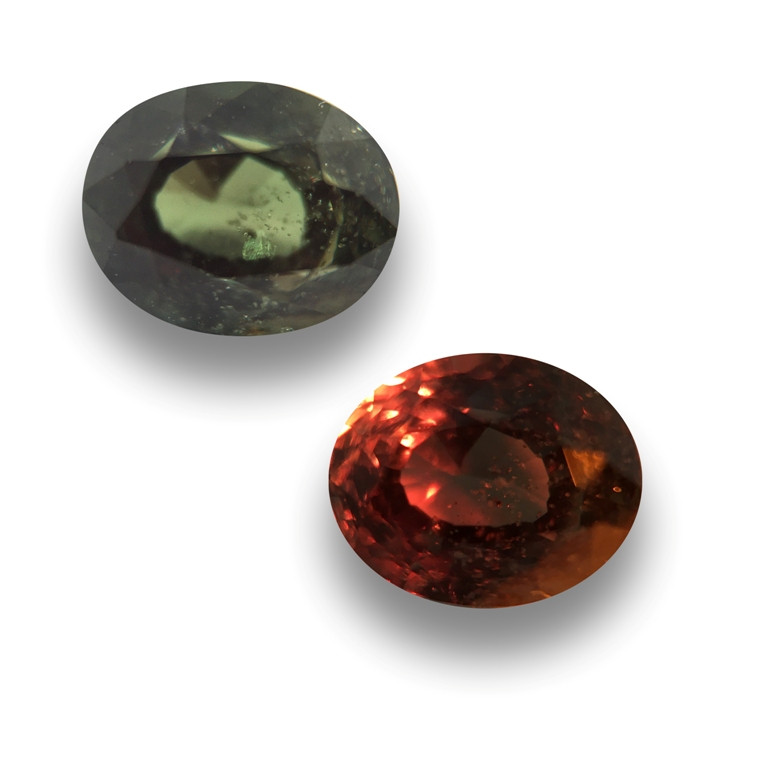
アレキサンドライト:意味、歴史、特性、価値
アレキサンドライトは、その希少性と魅惑的な変色力で知られるクリソベリルの一種です。子供の頃、色が変わるムードリングが大好きだった方にとって、アレキサンドライトはまさに洗練された大人の装いにぴったりです。
この宝石の起源はロシアですが、アレキサンドライトは世界中の宝石愛好家や宝石商に愛されています。
アレキサンドライトのニックネームの一つは「昼はエメラルド、夜はルビー」です。アレキサンドライトの宝石の色彩は、きらめく緑と赤が溢れる、洗練されたホリデーパーティーへと誘います。しかし、その美しさは一年を通して人々を魅了し続けるでしょう。
もっと詳しく知りたいですか?まさにここが最適な場所です。長年の経験と専門知識を活かし、アレキサンドライトの歴史、地質、特性から、そのパワー、意味、価格まで、アレキサンドライト宝石に関する包括的なガイドを作成しました。

アレキサンドライトについて
アレキサンドライトは、日光の下ではエメラルドグリーン、白熱灯の下ではルビーレッドに変化する非常に珍しい半貴石です。
でも、アレキサンドライトは一体どれほど希少なのでしょうか?アレキサンドライトは、最も希少な宝石の一つとされています。半貴石であるにもかかわらず、アレキサンドライトは4つの宝石(ダイヤモンド、サファイア、エメラルド、ルビー)よりも希少です。
夏生まれのエレガントな読者の皆様、アレキサンドライトはパールとムーンストーンと並んで6月の誕生石です。この石の持つ二面性は、ふたご座の誕生石としての価値にも通じます。
イベントプランナーの方々は、この月がウェディングシーズンのピークであることもご存知でしょう。6月に結婚式を挙げられた方は、アレキサンドライトは伝統的な結婚55周年記念の宝石として特別な意味を持ち、配偶者への記念品として最適です。

アレキサンドライトの仕様と特徴
クリソベリルの変種であるアレキサンドライトは、クリソベリルと同じ化学式(BeAl2O4)を持ちます。しかし、アレキサンドライトの独特の特性(特に変色特性)は、アルミニウムの一部がクロムに置換されているためです。中には、クロム含有量が1%未満の標本でもアレキサンドライトであるものがあります。
クロムの重要性のため、宝石学者の中にはアレキサンドライトの化学式を BeAl2O4 + Cr と記す人もいます。
実は、「アレキサンドライト」という用語は、国際鉱物学協会(IMA)が正式に認めた鉱物名ではありません。これは、クロム含有クリソベリルの一種を指すマーケティング用語としてよく使われています。
アレキサンドライトの結晶は、柱状で細長いものもあれば、板状で短いものもあります。アレキサンドライトのようなクリソベリルの結晶の多くは、顕著な条線を呈します。さらに、接触双晶や貫入双晶はクリソベリルの結晶によく見られ、これらの双晶がロゼットを形成することもあります。
アレキサンドライトの見分け方を知りたいですか?最も簡単な方法は、色の変化を確認することです。
アレキサンドライトは、太陽光の下では緑または青緑色に、白熱灯の下では赤、オレンジイエロー、またはマゼンタ色に見えます。アレキサンドライトは色を変えることができる数少ない宝石の一つであり、最も人気のある宝石であるため、宝石の色の変化は「アレキサンドライト効果」と呼ばれることがよくあります。
アレキサンドライトの鉱物特性は次のとおりです。
モース硬度:8.5
色: 光源によって異なります。日光または蛍光灯: 緑、青緑、緑がかった青、黄緑、または青みがかった灰色。白熱灯またはろうそくの光: 赤、ラズベリーレッド、赤紫、赤紫、藤色、すみれ色、灰紫、または茶みがかった赤
結晶構造:斜方晶系
光沢:ガラス質
透明性:透明から不透明
屈折率:1.745-1.759
密度:3.68~3.80
劈開:明瞭/良好~不良({110})
骨折:貝殻状または不均一/不規則
縞模様:白
発光: 蛍光あり - SW-UVおよびLW-UVで弱い赤色
多色性:存在し、強い;緑、黄橙色(または橙色)、赤(または紫がかった赤)
複屈折:0.008~0.010
分散:0.015
光学的効果:色の変化。ごく稀にシャトヤンシーやアステリズムが見られる。
鉱物学はさておき、アレキサンドライトの起源と歴史は何ですか?また、主にどこで発見されるのですか?
 上の写真:ダイヤモンドとアレキサンドライトが埋め込まれた金の指輪(美術館展示)|画像提供:スミソニアン・アメリカン・アート・ミュージアム・コレクション、パブリック・ドメイン
上の写真:ダイヤモンドとアレキサンドライトが埋め込まれた金の指輪(美術館展示)|画像提供:スミソニアン・アメリカン・アート・ミュージアム・コレクション、パブリック・ドメイン
ダイヤモンドとアレキサンドライトをあしらったゴールド
アレキサンドライトの歴史
アレキサンドライトの発見と命名には、数々の論争が巻き起こっています。物語の舞台は ロシアで、フィンランドの鉱物学者、ロシアの鉱物学者、そしてロシアのウラル鉱山の管理者が中心人物となっています。
まずは名前から。アレキサンドライトは、ロシア皇帝アレクサンドル2世に由来していることは明白です。(アナスタシア・ロマノフって聞いたことありますか?アレクサンドル2世は彼女の曽祖父です。)
1833年、ロシアのウラル山脈、特にエカテリンブルク近郊のエメラルド鉱山でこの石が発見されたとき、アレクサンドル2世はまだ皇帝ではありませんでしたが、16歳の誕生日を迎え、正式に皇位継承者となることを控えていました。アレキサンドライトは当時のロシア軍の2つの軍旗の色に合致していたため、その名前はまさに理にかなったものでした。
誰が最初にアレキサンドライトを発見し、命名したかとなると、事実は曖昧になります。
ノルデンショルドとペロフスキーの発見物語
一説によると、フィンランドの鉱物学者ニルス・グスタフ・ノルデンショルドがウラル鉱山のサンプルを調べ、最初にこの石を特定したと言われています。ノルデンショルドはロシアの鉱物学者レフ・アレクセーヴィチ・ペロフスキー伯爵からサンプルを入手しました。
ノルデンショルドは当初、エメラルドだと思ったが、硬度が高すぎた。その後、ろうそくの光の下でラズベリーレッドに変化するのを見て、それがクリソベリル(1792年に初めて記載された)の新しい変種であることに気づいた。
色が変わる現象を考慮して、ノルデンショルド氏はギリシャ語で「2」を意味するdiと「見えない」を意味するaphanes 、あるいは「現れる」を意味するphanを組み合わせて「diaphanite」という名前を提案した。
ペロフスキーはノルデンショルドの発見を知ると、1834年4月17日、アレクサンドル2世の16歳の誕生日のお祝いの席で、この石を「アレキサンドライト」と名付け、アレクサンドル2世に贈ったと伝えられている。(歴史家の中には、ペロフスキーが王室の歓心を買うことで自分の地位を高めるためにこの行為をしたと考える者もいる。)
アレキサンドライトの発見に関するその他の説
もう一つの起源説は、歴史家リチャード・A・ワイズによるものです。ワイズによると、ウラル鉱山の管理者であり、エカテリンブルク宝石工場の所長でもあったヤコフ・ココヴィン(ココヴィン・ヤコフ・ヴァシレヴィッチと表記されることもある)が、アレキサンドライトを最初に発見し、鑑定したと言われています。
ペロフスキー伯爵は後に、証拠がないにもかかわらず、ココヴィンが王室の宝石を盗んだと告発し、ココヴィンは失脚して投獄されました。この告発と、その後の獄中での自殺が、アレキサンドライトの歴史から彼を消し去るきっかけとなったのかもしれません。
興味深いことに、それ以前の発見はドイツで行われていた可能性があります。鉱物学教授のグスタフ・ローズは1829年、アレキサンドライトと一致するクリソベリルの新種について論文を発表しました。
そうは言っても、ほとんどの歴史家や宝石学者は、アレキサンドライトの最初の公式文書化された発見はロシアのウラル山脈であったことに同意しています。
いずれにせよ、この石は世界的に人気となり、1881年に皇帝が暗殺され、1917年にロシア貴族が最終的に終焉を迎えた後も、長きにわたりロシアおよび皇帝との結びつきを保ち続けた。
豊かな歴史を超えて、アレキサンドライトに関連する形而上学的な特性や信仰はあるのでしょうか?
 上の写真:蛍光灯(左)と人工光(右)の下で並べた、アクセントダイヤモンドが付いたキャッツアイアレキサンドライト宝石リング
上の写真:蛍光灯(左)と人工光(右)の下で並べた、アクセントダイヤモンドが付いたキャッツアイアレキサンドライト宝石リング
アレキサンドライトの意味
「カメレオンストーン」とも呼ばれるアレキサンドライトは、その色彩と同様に多様な象徴性を持っています。アレキサンドライトは一般的に知恵と幸運を象徴しますが、表面の補色は、その意味をさらに深く掘り下げています。
色彩理論の基礎に詳しい人なら誰でも、赤と緑が色相環で反対側、つまり「補色」の関係にあることを知っています。互いを引き立て合うだけでなく、2色の持つそれぞれの象徴性が組み合わさって、ダイナミックな組み合わせを生み出します。
赤の情熱、エネルギー、そして官能性は、平和的で成長志向の緑とは相反するように見えるかもしれません。しかし、スペクトル、つまり色相環の両極を取り入れることで、人生のあらゆる側面に自発性と革新性をもたらすことができます。
さまざまな文化の中で、アレキサンドライトにはどのような精神的な意味があるのでしょうか?
ロシアでは、アレキサンドライトは個人の誇りと名声を象徴します。その精神的な意味は非常に重視されており、石名の由来となった皇帝アレクサンドル2世は、アレキサンドライトの指輪をお守りとして毎日身に着けていたと伝えられています。
様々な文化において、アレキサンドライトは身に着けている人に危険を知らせるために色を変えると言い伝えられています。中国では、アレキサンドライトは血液と結び付けられ、循環器系の働きを良くすると信じられていました。ギリシャ人のアメジストに対する考え方に倣い、ヒンズー教徒はアレキサンドライトを酔い止めの薬とみなしていました。
治療法といえば、アレキサンドライトの治癒特性とは何でしょうか?

アレキサンドライトの治癒特性
アレキサンドライトの二面性を考えると、その癒しの力の多くがバランスに関係していることは驚くには当たらないかもしれません。精神的な面では、アレキサンドライトは私たちの心身の健康だけでなく、魂のバランスも整えてくれます。さらに、アレキサンドライトは自然界のあらゆるものが互いに作用し合っていることを私たちに思い出させてくれます。
感情的な癒し
多くの 緑色の宝石と同様に、アレキサンドライトの癒しの力は、私たちが中心を見いだし、周囲の世界を楽しむことを助けてくれます。変化は人生の一部であることを受け入れる力を与えてくれるアレキサンドライトは、私たちの日々の生活に癒しとマインドフルネスをもたらしてくれます。
身体の治癒
身体の健康面では、アレキサンドライトは循環器系を整えることで全身に良い効果をもたらします。特に、炎症、けいれん、緊張などの症状によく用いられます。
精神的な面に戻りますが、アレキサンドライトはチャクラヒーリングにどのような目的で使われるのでしょうか?
チャクラヒーリング
チャクラストーンとして、アレキサンドライトはクラウンチャクラを開き、バランスを整えます。クラウンチャクラは7つのチャクラの中で最も高次のチャクラであり、基本的な肉体的欲求から最高の精神的自己へと至る旅の頂点を成します。
クラウンチャクラが詰まっていると、繋がりを失い、インスピレーションを失い、錨もなく漂っているように感じるかもしれません。アレキサンドライトはチャクラを開き、人生に温かいエネルギーを注ぎ込み、力強い精神的な変容の舞台を整えます。
アレキサンドライトを治療に使い始める前に、適切なものを探す必要があります。
では、業界におけるアレキサンドライト宝石の価格設定と評価に影響を与える要因は何でしょうか?

アレキサンドライト宝石の特性
宝石の特性は、その真の市場価値を決定する上で不可欠です。石によっては、他の要素よりも重視される要素が異なります。例えば、ダイヤモンドのような無色の石では透明度がより大きな役割を果たしますが、有色の石では彩度がより重要になります。
アレキサンドライトの値段を知ったら、「なぜアレキサンドライトはこんなに高価なのか?」と疑問に思うかもしれません。
アレキサンドライトの価値は、採掘場所、大きさ、透明度など、様々な要素によって決まります。アレキサンドライトの価格を決める最も重要な要素は、色の質と、パーセンテージで表される色の変化の強さです。カラット重量も大きな要素です。
透明度とカットも重要な役割を果たしますが、これらの要素をそれぞれ個別に分析します。
色
アレキサンドライトの標準的な色は、日光や蛍光灯の下ではルビーレッドまたはラズベリーレッド、ろうそくや白熱灯の下ではエメラルドグリーンです。これは価値にも当てはまり、純粋な赤や緑に近いアレキサンドライトほど価値が高くなります。
青緑、茶赤、紫赤などの二次的な色合いは、石の価値を下げる可能性があります。しかし、純粋な緑や赤のアレキサンドライトを見つけるのは稀なので、鮮やかな赤紫や青緑は依然として価値があります。
場合によっては、アレキサンドライトは緑ではなく黄色や桃色に見えたり、赤ではなくホットピンクに変化したりすることがあります。
アレキサンドライトの色(他の特性も含む)も地域によって異なります。
ロシア:日光の下では青緑色またはエメラルドグリーン、白熱灯の下では赤色または赤紫色に見えることが多い。他の光源よりも複屈折と反射率が高い。
ブラジル:日光下では淡い青緑色、白熱灯下では淡い藤色となることが多い。内部でアルミニウムがガリウムに大きく置換されていることもある。ロシア産やスリランカ産の物質よりも複屈折が低い。ビルマ産やスリランカ産の物質よりも屈折率が高い。
スリランカ: 日光の下ではオリーブグリーンまたは黄緑色、白熱灯の下では赤褐色を帯びることが多い。ビルマ、ブラジル、ジンバブエ産の素材よりも複屈折性が高い。ロシアやジンバブエ産の素材よりも屈折率が低い。
ジンバブエ:日光の下では濃いエメラルドグリーンになることが多い。ロシアやスリランカ産の材料よりも複屈折性が低い。スリランカ、ビルマ、ブラジル産の材料よりも屈折率が高い。
一般的に、最低品質のアレキサンドライトの色は、顕著なグレーの色調をしています。
色の変化
色そのものに加え、石の色の変化の強さがおそらく最も重要な価値要因です。
色の変化の度合いは、パーセンテージで表すと5%から100%の範囲になります。中級品は通常50~60%程度ですが、最高品質のものは80~100%の強度になります。低品質のアレキサンドライトの色の変化は50%未満で、日光の下では黄緑色、白熱灯の下ではマホガニー色に見えることが多いです。
中級レベルのアレキサンドライトは、茶色がかっており、全体的に彩度が低い傾向があります。最高品質のアレキサンドライトは、ロシア産のように鮮やかな色をしています。実際、ロシアやブラジル産の高品質なアレキサンドライトは、他の地域で産出された同品質のアレキサンドライトの2倍の価格で取引されることもあります。
 上の写真:アレキサンドライト(ウラル産天然石アレキサンドライト)[ロシア語からの翻訳] | 画像提供:Salexmccoy、 CC-BY-SA-3.0
上の写真:アレキサンドライト(ウラル産天然石アレキサンドライト)[ロシア語からの翻訳] | 画像提供:Salexmccoy、 CC-BY-SA-3.0
明瞭さ
クラリティとは、宝石内部の目に見える内包物の程度を表すもので、内包物は宝石の透明度と価値を低下させる可能性があります。アレキサンドライトの場合、クラリティは最も重要な価値要因ではありませんが、重要な役割を果たします。
ダイヤモンドとは異なり、カラーストーンには公式のクラリティ評価システムはありません。しかし、カラーストーンのクラリティを判断するための非公式な評価システムが開発されました。
アレキサンドライトはタイプ II のクラリティ グレードに分類されます。つまり、最高品質の標本には拡大しないと内包物が見当たりませんが、ほとんどの標本には目に見える小さな内包物が見られます。
アレキサンドライトに見られる内包物には次のようなものがあります。
ごく稀に、針状または中空の管状のインクルージョンが束になって並び、アレキサンドライトに新たな光学現象をもたらすことがあります。シャトヤンシー(石全体に反射光が一本だけ広がる「キャッツアイ」効果)やアステリズム(石全体に反射光が複数の放射状に広がる「スター」効果)などです。これらは極めて稀少で、貴重です。
そうは言っても、石の透明度やクラリティに関係なく、非常に強く完全な色の変化を示すアレキサンドライトの方が常に価値が高くなります。
 上の写真: キャッツアイ効果(シャトヤンシー)を示すグリーンのアレキサンドライト カボション
上の写真: キャッツアイ効果(シャトヤンシー)を示すグリーンのアレキサンドライト カボション
カット
カットは他の宝石ほどアレキサンドライトの価値に影響を与えません。しかし、カラット重量は重要な役割を果たし、カットを決定することが多いです。
ご存知の通り、天然アレキサンドライトは非常に希少です。今日では宝石品質のアレキサンドライトを採掘するのは容易ではなく、数カラットを超えるファセット加工可能な標本を見つけることはほぼ不可能です。そのため、採掘されたアレキサンドライトの多くはファセットカットではなくカボションカットとなります。
しかし、最も価値が高く高品質なアレキサンドライトはファセットカットされています。米国宝石学会(GIA)によると、ファセットカットされたアレキサンドライトは、通常、ブリリアントカットのクラウン(上部)とステップカットのパビリオン(下部)を組み合わせたカットです。
カラット重量
ファセットカットされたアレキサンドライトのほとんどは1カラット未満の非常に小さなものです。色の変化の質はサイズが大きくなるにつれて低下する傾向があり、5カラットを超えるアレキサンドライトでは明確な色の変化は非常に稀です(5カラットを超えるアレキサンドライトはサイズだけでも非常に希少であり、3カラットを超える石は入手困難です)。
とはいえ、ファセットカットされたアレキサンドライトの中には、例外的に大きなものもいくつかあります。最大のものは、スリランカ産の65.7カラットの赤から緑へのカラーチェンジアレキサンドライトです。ロシア産のアレキサンドライトは、ファセットカットされて30カラット前後の宝石になっています。
大きなアレキサンドライトは希少であるため、1カラットを超えるとカラット当たりの価格は大幅に上昇し、2、5、8カラットを超えるとさらに上昇します。
トリートメントと合成
ほとんどのアレキサンドライトには処理が施されていませんが、透明度を高めるために亀裂充填や「オイル塗布」が行われる場合もあります。
対照的に、天然アレキサンドライトと同じ化学的性質と特性を持つ研究室で作られた石である合成アレキサンドライトは非常に一般的です。
1960 年代以降、科学者たちは、指輪やペンダントなどに加工できるアレキサンドライトを合成するさまざまな方法を発見してきました。
合成アレキサンドライト(特に熱水合成)は、天然のアレキサンドライトに比べて製造がはるかに早く、安価ですが、それでも製造コストが高く、最も高価な合成宝石の 1 つです。
1952年にアメリカ宝石工業会がアレキサンドライトを6月の誕生石に指定して以来、合成アレキサンドライトの需要が増加し、生産コストが上昇しています。その結果、需要と供給の基本的な経済学により、価格が上昇しました。
合成アレキサンドライトを作成するための多くの方法は、石の自然な形成を模倣しようとするものです。
 上の写真:日光下(左)と蛍光灯下(右)のアレキサンドライト結晶。標本はブラジル産|画像提供:Vzb83, GFDL, cc-by-sa-2.5,2.0,1.0
上の写真:日光下(左)と蛍光灯下(右)のアレキサンドライト結晶。標本はブラジル産|画像提供:Vzb83, GFDL, cc-by-sa-2.5,2.0,1.0
アレキサンドライトの起源と産地
アレキサンドライトは、ペグマタイト、渓流の小石、ドロマイト大理石など、様々な地質学的地域に産出されます。しかし、アレキサンドライトが採掘できる鉱山はごくわずかです。
アレキサンドライトの希少性については既に触れましたが、アレキサンドライトがなぜ希少なのかは、その生成過程に関係しています。その疑問に答えるには、アレキサンドライトの生成に必要な条件を見ていく必要があります。
アレキサンドライトは、ベリリウムとクロムが存在する場所で形成されます。ベリリウムは(最も希少な元素の一つであるため)すでに見つけるのが困難ですが、ベリリウムとクロムは全く異なる岩石から見つかるため、同時に見つかることはさらに稀です。
さらに、ベリリウムを豊富に含むペグマタイト流体は、マグマによって地表に向かって運ばれ、クロムを豊富に含む岩石に到達して結合し、クリソベリルが形成される必要があります。
ソ連には適切な条件が整っていたことは分かっています。しかし、ロシア以外では、アレキサンドライトはどこから来るのでしょうか?
採掘場所
ほぼ1世紀にわたり、ロシアは天然アレキサンドライトが採掘できる唯一の場所でした。しかし、1890年代までに鉱山はほぼ枯渇しました。
1987年、ブラジルの鉱山でアレキサンドライトが発見されました。その後すぐに、他の国々でもアレキサンドライトの鉱床が発見され、特に注目すべきものは以下のとおりです。
マダガスカル
スリランカ
ジンバブエ
ミャンマー
アレキサンドライトの他の小規模な産地は以下のとおりです。
マダガスカル
インド
オーストラリア
タンザニア
アレキサンドライトの産地によって、石の価格も左右されることがあります。

アレキサンドライト宝石の価値と価格
ご存知の通り、アレキサンドライトは希少で高価な宝石です。しかし、アレキサンドライトは一体どれくらい高価なのでしょうか?
ファセットカットされた1カラットのアレキサンドライトの小売価格は、1カラットあたり500ドルから20,000ドルの範囲であることが多いです。1カラット未満の最高品質の宝石は、1カラットあたり22,000ドルを超えることもあります。
全体および主要地域別に予想される、より大きなファセットカットのアレキサンドライトの 1 カラットあたりの一般的な価格範囲は次のとおりです。
1~2カラット:総額1カラットあたり2,000ドル~43,000ドル
1ctあたり10,500ドルから43,000ドル(ブラジル)
1ctあたり3,500ドルから6,500ドル(アフリカ)
1 ct あたり 4,000 ~ 5,000 ドル (スリランカ)
2~5カラット:総額1カラットあたり2,500ドル~86,500ドル
1ctあたり31,000ドルから86,500ドル(ブラジル)
1ctあたり6,500ドルから13,500ドル(アフリカ)
1 ct あたり 3,000 ~ 33,500 ドル (スリランカ)
5~8カラット:総額1カラットあたり7,500ドル~30,000ドル
1ctあたり23,000ドルから30,000ドル(アフリカ)
12,000ドルから30,000ドル/ct(スリランカ)
8カラット以上:総額1カラットあたり13,000ドルから60,000ドル
1ctあたり30,000ドル以上(アフリカ)
13,000ドルから36,500ドル/ct(スリランカ)
もちろん、品質も重要な役割を果たします。
低品質の石は通常1カラットあたり2,000ドル未満ですが、中品質の石は1カラットあたり7,000ドルから12,000ドルの範囲です。予算を抑えるコツとしては、適度な色の変化がある小さめのアレキサンドライトを選ぶことです。
キャッツアイ アレキサンドライト カボションははるかに安価ですが、それでも価格帯は幅広く、当社のような卸売価格では 1 カラットあたり約 100 ドルから 5,000 ドルの範囲です。
当社のアレキサンドライト原石の価格は、合計で約 150 ドルから 4,000 ドルの範囲です。
そのような投資をするのであれば、宝石の寿命を延ばすためにあらゆる予防策を講じる必要があります。
では、アレキサンドライトジュエリーの美しさを保つためのお手入れのヒントは何でしょうか?
アレキサンドライトのケアとメンテナンス
モース硬度8.5のアレキサンドライトは、ダイヤモンド、サファイア、ルビーに次いで傷がつきにくい宝石です。しかし、残念ながら無敵というわけではありません。そのため、適切な宝石のお手入れは必要です。
石を一生、あるいはそれ以上長持ちさせるためには、次のようなものにさらさないようにしてください。
極度の暑さ(通常の暑さは大丈夫です)
強烈な打撃
大量の家庭用洗剤
幸いなことに、アレキサンドライトの洗浄は簡単です。昔ながらの石鹸と温水を使った洗浄でも十分ですが、機械洗浄機を使っても大丈夫です。機械洗浄機(例えば超音波洗浄機)の使用を避けるべきなのは、石にひび割れが詰まっている場合だけです。
よくある質問
アレキサンドライトについてまだ質問がありますか?お答えします!
アレキサンドライト特有の色が変わる特性とは何ですか? また、この現象の原因は何ですか?
アレキサンドライトの特徴的な光学現象は、異なる種類の照明の下で色が変化することです。通常、自然光(日光)の下では暖かい紫または赤になり、人工光(白熱灯またはろうそくの光)の下では冷たい緑または青緑になります。
色の変化現象は、アレキサンドライトにも見られる多色性とは異なります。多色性は、石の屈折率が1つではなく2つある複屈折性に関係していますが、色の変化は、より稀なメカニズムによって起こります。
アレキサンドライトの色が変わる理由は、主にそのクロム(Cr3+)含有量と光との相互作用によるものです。 具体的には、その相互作用を私たちがどのように認識するかです。
太陽光と蛍光灯は主に青と緑の波長を放射しますが、人工光は赤と紫の波長をより多く放射します。アレキサンドライトに含まれるクロムイオンは、それぞれの色相、つまり自然光では緑と青、人工光では赤と紫を反射します。
異なるアレキサンドライト標本には、顕著な違いや色の変化が見られますか?
まさにその通りです。典型的な色の変化は、日光の下では純粋な緑から人工光の下では純粋な赤へと変化することですが、すべてのアレキサンドライトが同じというわけではありません。
不純物として、クロムの含有量はアレキサンドライトによって異なります。さらに、鉄やチタンなどの不純物が含まれている場合もあります。
そのため、アレキサンドライトの中には、純粋な赤から緑への色の変化が強いものもあれば、オレンジや茶色がかった赤から黄緑やオリーブグリーンなど、純粋ではない色合いへの色の変化が弱いものもあります。
宝石鑑定士はアレキサンドライトのグレーディングにおいて、太陽光と白熱灯を二つの基準として用います。しかし、照明の種類によっては、異なる色が見える場合もあります。例えば、長波紫外線ランプの下では、明るく輝く赤や紫が見えることがあります。
さらに、アレキサンドライトの色は、発光と多色性により異なって見えることがあります。
アレキサンドライトの希少性と変色能力は、宝石市場におけるその価値にどのような影響を与えるのでしょうか?
一言で言えば、非常に。
もう少し詳しく説明すると、アレキサンドライトは、その主要元素であるベリリウムとクロムが自然界で同時に見つかる可能性が低いことから、既に希少な石です。高品質でファセット加工可能なアレキサンドライトはさらに希少です。
これらの事実と、アレキサンドライトが正式な誕生石として人気を集めていること、および 2 つの補色間の顕著な変化と相まって、アレキサンドライトは市場で最も価値のある宝石の 1 つとなっています。
ジュエリー作りやその他の用途におけるアレキサンドライトの主な用途は何ですか?
アレキサンドライトは工業用途には希少性が高いですが、その美しい外観と優れた装着性により、ジュエリーの選択肢は豊富です。
多くの宝石職人が、小粒ながらも高品質なファセットカットのアレキサンドライトを、装飾的な高級ジュエリーにセッティングしています。人気の例としては、アレキサンドライトのペンダントや、シルバーリング、ドロップイヤリング、アレキサンドライトのセンターストーンをホワイトダイヤモンドで囲んだスタッドピアスなどのマルチストーンジュエリーが挙げられます。
多くの購入者は、6 月に生まれた友人への誕生石の贈り物や、配偶者への結婚 55 周年記念の贈り物など、特別な機会のためにカスタム アレキサンドライト ジュエリーを選びます。
 上の写真:蛍光灯(左)と人工光(右)の下で見たファセットカットのカラーチェンジサファイア(アレキサンドライト類似石)
上の写真:蛍光灯(左)と人工光(右)の下で見たファセットカットのカラーチェンジサファイア(アレキサンドライト類似石)
本物のアレキサンドライトと合成石や処理石をどのように見分けることができますか?
お持ちのアレキサンドライトが本当にアレキサンドライトであるかどうかを確実に知りたい場合は、米国宝石学会 (GIA)や米国宝石協会 (AGS)などの信頼できる機関で等級付けと認定を受けることを強くお勧めします。
そういう意味では、アレキサンドライトのような価値の高い石を購入する前に、必ず鑑定書を確認してください。アレキサンドライトに一般的に見られるのは亀裂充填処理だけですが、素人目には見分けがつきにくいため、信頼できる鑑定書であれば、この処理も見分けられるはずです。
ラボでの作成に関しては、宝石鑑定士は、次のような顕微鏡レベルでの特徴的な兆候を探すことで、合成アレキサンドライトを識別できることが多いです。
湾曲した条線/湾曲した成長線
金属板
フラックス充填キャビティ
プラチナの含有物
種子材料
ベールのような介在物
渦巻き状の外観
ガス泡(例えば、チョクラルスキー法で石を作ったときに発生する小さな黒い泡)
フラックス残留物(場合によっては平行負結晶または粉塵を含む)
警告: 怪しい販売業者の中には、実際には類似石(見た目は似ているが全く異なる石)に「合成アレキサンドライト」というラベルを貼っているところもあります。
一般的なアレキサンドライトの模造品は次のとおりです。
最後になりましたが、重要なことです...
アレキサンドライト宝石を使った有名な作品や重要な作品はありますか?
ええ、その通りです!アレキサンドライトは既にかなり有名ですが、さらに際立つ標本がいくつかあります。
ホイットニー・アレキサンドライト:ブラジル産の17.08カラット、クッションカットの天然アレキサンドライト。ラズベリーレッドからティール色に変化。2009年にコラリン・ライト・ホイットニー氏からスミソニアン自然史博物館に寄贈。
スミソニアン・アレキサンドライト:スリランカ産の65.70カラット、クッションカットの天然アレキサンドライト。緑から赤褐色に変化する。スミソニアン自然史博物館に展示。
最大のカットのアレキサンドライト:日本の個人が所有する141.92カラットのファセットカットの天然アレキサンドライト。2010年にギネス世界記録に最大のカットのアレキサンドライトとして登録されました。
最も高価なアレキサンドライト: 緑から紫に色の変化がある、ロシア産の21.41カラットのクッションカットの天然アレキサンドライト。2014年にクリスティーズで132万5000スイスフラン(約147万米ドル、1カラットあたり6万8000米ドル以上)で落札されました。
サザビーズのセイロンアレキサンドライト:スリランカ産の26カラットのファセットカットアレキサンドライト。2015年に75万4000ドル(1カラットあたり2万9000ドル)で落札された。
アレキサンドライトとダイヤモンドの指輪:ブラジル産の15.58カラットのファセットカットのアレキサンドライトがアクセントダイヤモンドをあしらった指輪。2011年に722万香港ドル(92万ドル以上、1カラットあたり約6万ドル)で落札された。
キャッツアイ アレキサンドライト リング: ブラジル産の 23.19 カラットのキャッツアイ アレキサンドライト カボションが、アクセント ダイヤモンドをあしらったリングにセットされています。2011 年にサザビーズで 11,860,000 香港ドル (152 万ドル以上) で落札されました。
これらは最も有名なアレキサンドライトかもしれませんが、他にも選べる美しいアレキサンドライト石はたくさんあります。
 上の写真:ホイットニー・アレキサンドライト、撮影:チップ・クラーク|画像提供:スミソニアン国立自然史博物館
上の写真:ホイットニー・アレキサンドライト、撮影:チップ・クラーク|画像提供:スミソニアン国立自然史博物館
アレキサンドライトであなたの色を輝かせましょう!
アレキサンドライトについて知っておくべきことはすべてこれで終わりです!この石はなかなか手に入らないかもしれませんが、だからこそ一つひとつが特別なのです。
アレキサンドライトは、私たちに自分自身を制限する必要はないということを思い出させてくれます。この洗練された宝石が情熱的な赤から穏やかな青まで、自由に変化していくなら、私たちは自信を持って自分のあらゆる側面を受け入れることができるでしょう。
イギリスの作家リリー・アダムス・ベックの言葉を引用すると、「ここには、昼間は深い緑色の中に秘密を隠しているクリソベリルがあるが、夜になると、燃えるような深紅の恍惚の炎が月に向かって輝く。」
今すぐアレキサンドライトの石で可能性の世界を体験しましょう!
Gemstone Encyclopedia検索
最新記事
ヤシ象牙彫刻は、植物象牙とも呼ばれ、南米のヤシ科植物フィテレファス属のヤシの実から倫理的に採取された、象牙の天然代替品です。このガイドでヤシ象牙についてすべて学びましょう!
15th Jan 2026
レインボーラティスサンストーンは、様々な内包物によって3つのゴージャスな光学的効果を持つ長石の一種です。燃えるように鮮やかな色合いと格子模様が、コレクターにとって希少な宝石となっています。
12th Jan 2026
記事のカテゴリ
How To's is where you will find helpful articles from gem Rock Auctions on how to cut gemstones, select gemstones and buy gemstones.
9記事数

